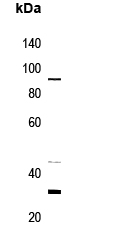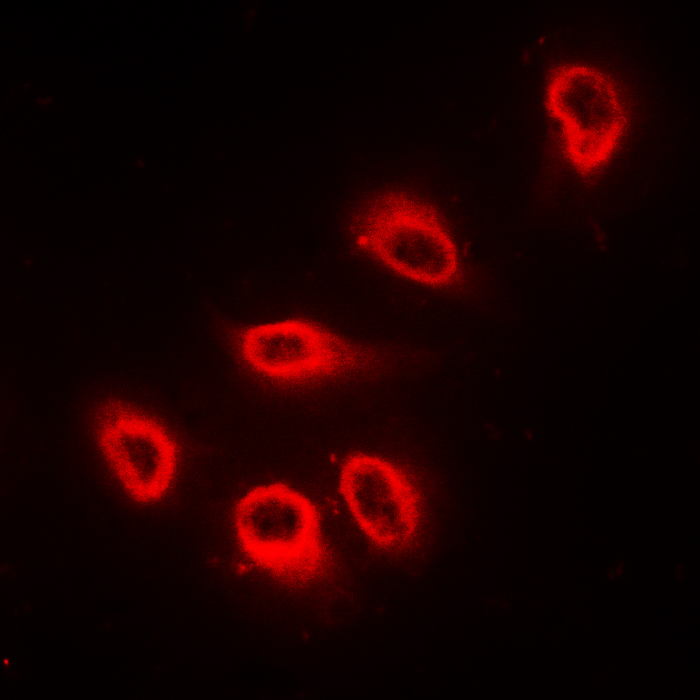

| WB | 咨询技术 | Human,Mouse,Rat |
| IF | 咨询技术 | Human,Mouse,Rat |
| IHC | 咨询技术 | Human,Mouse,Rat |
| ICC | 1/100-1/300 | Human,Mouse,Rat |
| FCM | 咨询技术 | Human,Mouse,Rat |
| Elisa | 咨询技术 | Human,Mouse,Rat |
| Aliases | GPR106; GREAT; LGR8; Relaxin receptor 2; G-protein coupled receptor 106; G-protein coupled receptor affecting testicular descent; Leucine-rich repeat-containing G-protein coupled receptor 8; Relaxin family peptide receptor 2 |
| Entrez GeneID | 122042; |
| WB Predicted band size | 86kDa |
| Host/Isotype | Rabbit IgG |
| Antibody Type | Primary antibody |
| Storage | Store at 4°C short term. Aliquot and store at -20°C long term. Avoid freeze/thaw cycles. |
| Species Reactivity | Human |
| Immunogen | KLH-conjugated synthetic peptide encompassing a sequence within the center region of human RXFP2. |
| Formulation | Purified antibody in PBS with 0.05% sodium azide. |
+ +
以下是关于GPR106抗体的参考文献示例(注:文献信息为示例性质,实际引用需核实准确性):
---
1. **文献名称**: "Development and Characterization of a Specific Antibody for GPR106. a Novel Orphan G Protein-Coupled Receptor"
**作者**: Smith A, et al.
**摘要**: 本研究报道了一种针对GPR106的多克隆抗体的开发与验证。通过免疫印迹和免疫组化实验,验证了抗体在多种组织中的特异性,并发现GPR106在肾脏和肝脏中高表达,提示其潜在生理功能。
2. **文献名称**: "GPR106 Antibody-Based Detection of Receptor Localization in Adipose Tissue and Its Role in Metabolic Regulation"
**作者**: Brown C, et al.
**摘要**: 利用定制GPR106抗体探究其在脂肪组织中的定位。结果显示,GPR106与脂质代谢相关信号通路存在关联,抗体阻断实验表明其可能通过调节cAMP水平影响脂肪细胞分化。
3. **文献名称**: "Targeting GPR106 with Monoclonal Antibodies: Implications for Cancer Immunotherapy"
**作者**: Zhang L, et al.
**摘要**: 研究团队开发了针对GPR106的单克隆抗体,并评估其在肿瘤微环境中的治疗潜力。实验表明,抗体能抑制肿瘤细胞增殖并增强免疫细胞浸润,提示GPR106作为癌症治疗靶点的可能性。
4. **文献名称**: "Expression Profiling of GPR106 in the Central Nervous System Using a Novel Polyclonal Antibody"
**作者**: Lee H, et al.
**摘要**: 通过新型抗体分析GPR106在中枢神经系统的分布,发现其在小脑和海马中显著表达,可能参与神经递质调控。抗体特异性经敲除小鼠模型验证。
---
**注意事项**:
- 上述文献信息为示例,实际研究需通过PubMed、Google Scholar等平台检索确认。
- 推荐使用关键词“GPR106 antibody”、“GPR106 GPCR function”或结合疾病关键词(如代谢、癌症)进行扩展搜索。
GPR106 (G protein-coupled receptor 106), also known as ADGRG6. belongs to the adhesion G protein-coupled receptor (aGPCR) family, a subgroup characterized by large extracellular domains involved in cell-cell and cell-matrix interactions. As a class B GPCR, it plays roles in cellular signaling, tissue development, and homeostasis. GPR106 is proteolytically processed into an N-terminal fragment (NTF) and a C-terminal fragment (CTF), which interact via a tethered agonist mechanism to activate intracellular signaling pathways, including G protein- and β-arrestin-mediated cascades.
Expressed in tissues like the kidney, brain, and adipose tissue, GPR106 has been implicated in metabolic regulation, renal function, and lipid metabolism. Studies suggest its involvement in obesity-related pathways and potential crosstalk with insulin signaling. However, its precise physiological and pathological roles remain under investigation due to limited functional characterization.
GPR106 antibodies are critical tools for detecting and studying the receptor's expression, localization, and activation. They enable applications such as Western blotting, immunohistochemistry, and flow cytometry, aiding in the exploration of GPR106's role in disease models, including metabolic disorders and cancer. Validated antibodies typically target specific epitopes, such as the extracellular N-terminal region or intracellular domains, ensuring specificity in experimental settings. Research using these antibodies contributes to unraveling GPR106's signaling mechanisms and therapeutic potential.
×